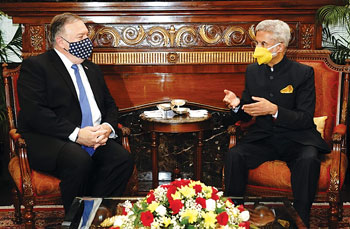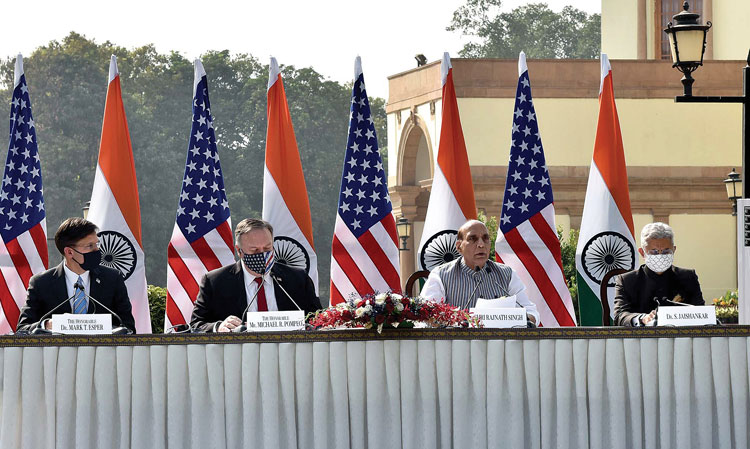INDIAN ARMED FORCES CHIEFS ON
OUR RELENTLESS AND FOCUSED PUBLISHING EFFORTS

SP Guide Publications puts forth a well compiled articulation of issues, pursuits and accomplishments of the Indian Army, over the years

I am confident that SP Guide Publications would continue to inform, inspire and influence.

My compliments to SP Guide Publications for informative and credible reportage on contemporary aerospace issues over the past six decades.
India-US: Game Changer Meeting
Agreements during the visit has opened a new chapter in India-US strategic partnerships and will prove to be a game changer in strategic equations in the region

The historic visit of US Defence Secretary Mark T. Esper and Secretary of State Mike Pompeo to India on October 26 and 27 has finally laid to rest all speculations in the bilateral strategic partnerships. The joint historic visit to New Delhi for 2+2 dialogue with Indian Defence Minister Rajnath Singh and External Affairs Minister Dr S. Jaishankar will be remembered for decades to come. The visit has been able to raise the fourth and final pillar of foundation agreement BECA (Basic Exchange and Cooperation Agreement), over which India and US will be building a new structure of bilateral strategic partnership. The two defence establishments, during this third annual 2+2 dialogue, have finally been able to showcase to the strategic community world over that India and US are now the latest strategic partners in letter and spirit. The completion of all four Foundational Agreements during the visit has opened a new chapter in India-US strategic partnerships and will prove to be a game changer in strategic equations in the region.
In the backdrop of continuing bellicosity by the Chinese army, the latest BECA agreement has assumed much significance, as India can hope for early delivery of more sophisticated combat capability enhancing systems, which will prove to be a game changer in the current eyeball to eyeball military standoff of the two armies on the border areas of Eastern Ladakh.
Besides BECA, the two sides also deliberated at length, the need for enhanced maritime information sharing and maritime domain awareness between their Navies and affirmed their commitment to build upon the existing defence information-sharing at the joint-service and service-to-service levels and explore new areas of mutually beneficial cooperation. In this context, both the countries decided that the discussions on Maritime Information Sharing Technical Agreement (MISTA) will continue. According to a former Director of Intelligence and Information operations for the US pacific fleet, Captain James Fannel (Retd), on the strength of BECA and MISTA, India will be able to join the existing “fleet intelligence federation” which will be a great leap forward in maritime security cooperation. This will help in operationalising the QUAD alliance and turn it into a credible deterrent against China’s militant expansionism.
The visit generated much interest among Indian public and strategic community in particular because of continuing Chinese aggressive behaviour since last six months
After the joint ministerial talks, a senior official of the Indian External Affairs Ministry said that defence and security cooperation between India and US has emerged as a key pillar of our strategic partnership. Our defence trade, joint exercises, industrial and technology collaboration and military to military ties have expanded in recent times. According to US Defence secretary Mark Esper, “from collaborating on emerging technologies to advancing defence trade priorities, India and US have agreed to continue to work in partnership to address pressing global security challenges.”
In the backdrop of China’s assertiveness in the South China Sea and frequent forays of Chinese warships in the Indian Ocean, the two sides very significantly affirmed their commitment to increased cooperation between the Indian military and US Central Command and Africa Command, including broader participation in exercises and conferences, so as to promote shared security interests.

During the meeting, both sides asserted, that they have reiterated the importance of peace, stability and prosperity for all countries in the region by upholding the rules based international order, ensuring freedom of navigation in international seas, promoting open connectivity and respecting the territorial integrity and sovereignty of all States. They also took a dig at China by asserting that a multi polar world must have multi polar Asia as its basis. This is significant in view of Chinese designs to singularly dominate Asia.
The visit generated much interest among Indian public and strategic community in particular because of continuing Chinese aggressive behaviour since last six months and anti China rhetoric expressed publicly by Pompeo-Esper duo in Hyderabad House. Though, China provided a backdrop to the visit, the two countries were discussing the completion of fourth Foundational agreement BECA (Basic Exchange Cooperation Agreement for Geospatial Cooperation) over the last one decade. When the two countries put their final seal of approval on the third foundation called the Communication compatibility and Security Agreement (COMCASA) in 2018, India had expressed its readiness to sign on the BECA, which will enable deepest collaboration between the defence forces of the two democratic powers. The first foundational agreement called The General Security of Military Information Agreement (GSOMIA) was signed way back in 2002 during the regime of then NDA Prime Minister Atal Bihari Vajpayee. Fourteen years later, in 2016, the second foundational agreement, called the Logistics Exchange Memorandum of Agreement (LEMOA) was inked.
Both Indian and American defence and foreign ministers described this as a comprehensive, resilient and multi faceted Major Defence Partnership (MDP) between India and United States
The conclusion of the fourth and last foundation agreement marks the end of the prolonged phase of mutual trust building and sets the stage for more comprehensive defence and security cooperation. These foundational agreements will also pave the way for acquisition of unmanned combat aerial vehicles, which are controlled by satellite links to attack the targets hundreds of kilometres away. In fact, the 2018 agreement on COMCASA and latest BECA agreement will clear the path for India to acquire more sophisticated weapon systems like armed drones Reapers and Predators which will assist in long range accurate targeting of enemy targets on land and oceans. The COMCASA will enable India to access advanced military platforms with encrypted and secure communications and data links like the armed drones. BECA will assist Indian armed forces in acquiring real time exchange of geo-spatial intelligence through advanced satellite imagery topographical and aeronautical digital data for long range navigation and accurate strikes against the enemy targets. Following these agreements, the armed forces can now expect the government to clear the proposal to acquire 30 Hunter killer weaponised Sea Guardian or MQ-9 Reaper drones. India is also willing to work with American experts to jointly develop Drone Swarms, which can overwhelm and damage enemy’s air defence systems, thus destroying enemy’s radar and defensive mechanism. Indian defence minister Rajanth Singh had indicated during his opening remarks made available to media that both countries have identified priority near term projects for joint development, which need to be fast tracked under the defence technology and trade initiative (DTTI).

After the 2+2 talks the India-US Joint Statement acknowledged India’s contributions to global supply chain of major defence plat-forms and commitment to defence innovation. Both sides reiterated the importance of defence technology and trade initiative and stated their intention to fast track projects under DTTI.
Though, the conclusion of the BECA agreement was very much expected, the focus of the 2+2 dialogue was on Indo-Pacific region, where China poses strong challenge not only to Indian and US strategic and economic interests, but to the whole world, as China advances its claims over large part of the South China Sea. As the US military and political leaders have often emphasised that the South China Sea is not China’s sea, the maritime area must be open to all traffic, which is known as international waters under the United Nations Law of the Seas (UNCLOS).
The Indian Defence Minister Rajnath Singh talking about the high level visits from US, said that the “2+2 dialogue has a politicomilitary agenda that underlines our close bilateral relationship. Our national security convergences have obviously grown in a more multipolar world. We must ensure that India US bilateral partnership makes a positive contribution to the world arena.” To continue various military engagements, both countries gave green signal to tri-service Amphibious Tiger Triumph HADR exercise and the Army Exercises Yudh Abhyas and Vajra Prahar in 2021.
During the talks India reiterated the importance of peace, stability and prosperity for all countries in the region. According to Rajnath Singh, this is possible only by upholding the rules based international order, ensuring the freedom of navigation in the international seas, promoting open connectivity and respecting the territorial integrity and sovereignty of all the states. A multipolar world must have a multi polar Asia, as it’s basis.
Significantly, the 2+2 dialogue was held during the 15th anniversary of the inaugural India-US defence framework agreement. Both Indian and American defence and foreign ministers described this as a comprehensive, resilient and multi faceted Major Defence Partnership (MDP) between India and United States. During the deliberations the two sides expressed satisfaction in the implementation of the Logistics Exchange and Memorandum of Agreement (LEMOA) and Communications, Compatibility and Security Agreement (COMCASA), including the expansion of secure communications capabilities to include secure video tele-conference between their respective navies, armies and Air forces as well between respective Foreign and Defence ministries.
In view of advancing Chinese capabilities in interfering in the internet infrastructure of rival countries, India and US, significantly, had earlier convened India-US Information and Communication Technology (ICT) working group, which reaffirmed commitment towards open and reliable and secure internet as well as multi stake holder model of Internet governance. They emphasised on fostering cooperation between their Industry and academia for an open , secure and resilient supply of strategic material and critical infrastructure and to independently evaluate the risk associated with deployment of emerging ICT technologies including 5G networks. Prior to this meeting, India and US had also in mid-September organised first India-US defence Cyber security dialogue.
Thus the third annual 2+2 ministerial dialogue has paved the way for further deepening of multifaceted defence and security cooperative relationship between India and USA. The fact that, the dialogue happened just seven days before the Presidential elections in US and three weeks after the four nation QUAD (US, Australia, Japan, India) meeting in Tokyo, speaks volumes of its strategic significance. Since, there is a bipartisan support in US administration for strengthening strategic partnership with India and there are strong anti-China sentiments among all political class of US, India hopes that whichever party forms the government, India-US defence and security partnerships will continue to prosper.





